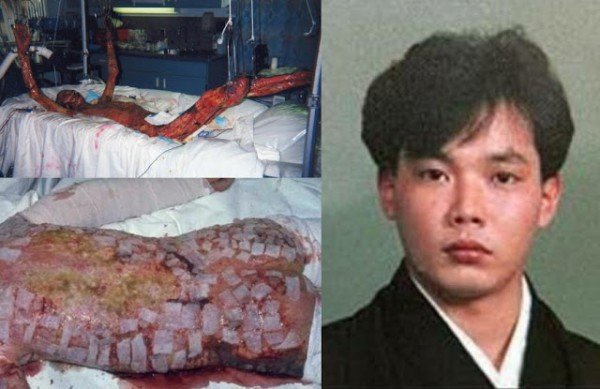Introduction to the Hisashi Ouchi nuclear accident
In the annals of nuclear history, few stories are as harrowing and poignant as that of Hisashi ouchi photos. A man whose life took a tragic turn due to a catastrophic accident, Ouchi became an emblem of the dangers associated with radiation exposure. The chilling details surrounding his incident are often overshadowed by the ethical debates sparked by images released after his ordeal. These snapshots tell a story not only of pain and suffering but also serve as stark reminders about the consequences of nuclear mishaps.
Radiation poisoning is more than just a scientific term; it represents real human experiences fraught with anguish and fear. As we delve into this unsettling narrative, we’ll uncover what happened to Hisashi ouchi photos, examine the impact of radiation on our bodies, and explore why his photographs have stirred such controversy. Prepare for an eye-opening journey through one man’s tragedy that ignited discussions on safety standards in nuclear facilities worldwide.
What is radiation poisoning?
Radiation poisoning occurs when the body absorbs a significant amount of ionizing radiation. This type of radiation can disrupt cellular functions and cause severe health issues.
Symptoms vary depending on the dose received. Mild exposure may lead to nausea and fatigue, while higher levels can result in life-threatening conditions like organ failure and death.
The body’s response hinges on several factors, including the duration of exposure and individual susceptibility. Certain organs are more vulnerable, particularly those rapidly dividing cells such as bone marrow.
Treatment options exist but are limited. Medical professionals focus on alleviating symptoms and preventing further damage rather than reversing the effects entirely.
Understanding radiation’s impact is crucial for safety protocols, especially in environments where exposure risk is prevalent, such as nuclear power plants or medical facilities using radiological equipment.
The impact of radiation on the human body
Radiation can wreak havoc on human physiology. When exposed, cells may sustain damage at the molecular level. This often leads to mutations and can disrupt normal cellular functions.
Acute exposure results in immediate effects like nausea, vomiting, and fatigue. These symptoms are just the beginning of a long-term battle within the body.
Over time, radiation can compromise bone marrow production. Hisashi ouchi photos A weakened immune system makes individuals more susceptible to infections and diseases.
Further complicating matters is the risk of cancer development years later due to genetic changes induced by radiation exposure. Solid tumors or blood cancers become possible outcomes for those affected by significant doses.
The severity depends on factors such as dose intensity and duration of exposure. Each case is unique, leaving lasting impacts that vary from person to person.
The story of Hisashi Ouchi and his exposure to radiation
Hisashi ouchi photos was a young technician working at the Tokaimura nuclear facility in Japan. On September 30, 1999, an accident changed everything. A criticality event occurred due to improper handling of uranium fuel.
Ouchi and his colleagues were exposed to lethal doses of radiation almost instantly. The situation spiraled out of control as they struggled for safety amidst chaos.
Emergency responders rushed him to the hospital where doctors faced unprecedented challenges. His body began to deteriorate rapidly under the intense effects of radiation poisoning.
The aftermath left Ouchi fighting for his life against unimaginable odds. Hisashi ouchi photos He endured agonizing treatments and procedures that pushed medical science to its limits.
His story became a haunting reminder of the dangers inherent in nuclear energy, highlighting both human error and technological risks associated with it.
Controversy surrounding the release of Hisashi Ouchi’s photos
The release of Hisashi ouchi photos stirred intense controversy. Many argued that sharing these images was an invasion of privacy and dignity, especially considering the tragic circumstances surrounding his death.
Critics emphasized the ethical implications. His suffering should not be a spectacle for public consumption. They questioned whether such images serve any purpose beyond sensationalism Hisashi ouchi photos.
On the other hand, some believed these visuals highlighted the real dangers associated with radiation exposure. They contended that seeing the consequences could educate others about nuclear safety.
However, this opened a broader discussion about media responsibility and human rights. Balancing awareness with respect for individuals remains a complex issue in cases like Ouchi’s.
These debates continue to resonate within both media circles and society at large, reflecting deeper values regarding empathy and humanity amid tragedy.
Lessons learned from the Hisashi ouchi case
The tragedy of Hisashi ouchi photos serves as a stark reminder of the dangers associated with nuclear energy. Proper safety protocols are essential in preventing such incidents.
Training and preparedness for emergency situations must be prioritized within nuclear facilities. Staff need to understand radiation risks and how to mitigate them effectively.
Additionally, transparency is crucial during crises. Information should flow freely between authorities, employees, and the public to foster trust and ensure safety measures are understood.
Medical responses also require reevaluation. Hisashi ouchi photos The treatment for radiation exposure needs continuous improvement based on past cases like Ouchi’s.
Ethical considerations surrounding patient privacy cannot be ignored. The release of sensitive images can have lasting effects on families and society’s perception of such tragedies. Addressing these lessons can lead to safer practices in the future while honoring those affected by similar accidents.
Conclusion
The incident involving Hisashi ouchi photos serves as a haunting reminder of the dangers associated with nuclear energy and radiation exposure. His tragic story highlights the severe consequences that can arise from workplace accidents in high-risk environments.
Radiation poisoning is not just a medical term; it represents real human suffering. The devastating impact on Ouchi’s body illustrates how vulnerable we are to invisible threats. Hisashi ouchi photos It compels us to reflect on safety protocols and the importance of rigorous training for those working in hazardous industries.
The release of photos related to Ouchi’s condition sparked intense debate about ethics, privacy, and respect for individuals facing unimaginable hardships. These images serve as a stark visual representation of his struggle but also raise questions about consent and humanity during crises.
Through this tragedy, there have been significant lessons learned regarding safety measures, emergency response plans, and the treatment of victims exposed to radiation. As society continues to rely on nuclear technology for power and medicine, remembering incidents like Ouchi’s can help prevent future tragedies while fostering compassion for those affected by such calamities.
Hisashi ouchi photos legacy lives on through awareness surrounding radiation exposure risks. It’s crucial that we honor his memory by advocating for better practices that prioritize health and safety above all else.

















